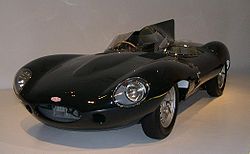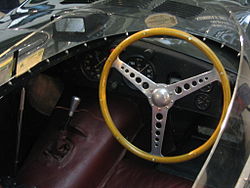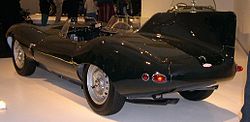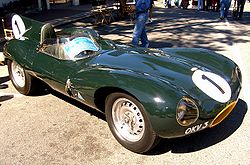- Jaguar D-Type
-
Jaguar D-Type 
Manufacturer Jaguar Cars Production 1954–1957 Predecessor Jaguar C-Type Successor Jaguar E-Type Class Racing car Body style Roadster Related Jaguar XKSS The Jaguar D-Type, like its predecessor the C-Type, was a factory-built race car. Although it shared the basic straight-6 XK engine design (initially 3.4 litres and uprated to 3.8 litres in the late fifties) with the C-Type, the majority of the car was radically different. Perhaps its most ground-breaking innovations were the use of disc brakes, and the introduction of a monocoque chassis, which not only introduced aircraft-style engineering to competition car design, but also an aeronautical understanding of aerodynamic efficiency. The D-Type was introduced purely for competition, but after Jaguar withdrew from racing, the company offered the remaining, unfinished chassis as the roadgoing Jaguar XKSS, by making changes to the racers: adding an extra seat, another door, a full-width windshield and primitive folding top, as concessions to practicality. However, on the evening of 12 February 1957, a fire broke out at the Browns Lane plant destroying nine of the twenty five cars that had already been completed or in semi-completion. Production is thought to have included 53 customer D-Types, 18 factory team cars, and 16 XKSS versions.
Contents
Design
 Double overhead cam 3.4 litre straight six cylinder XK6 engine
Double overhead cam 3.4 litre straight six cylinder XK6 engine
The new chassis followed aircraft engineering practice, being manufactured according to monocoque principles. The central tub, within which the driver sat, was formed from sheets of aluminium alloy. To this was attached an aluminium tubing subframe carrying the bonnet, engine, front suspension, and steering assembly. The rear suspension and final drive were mounted directly onto the monocoque itself. Fuel was carried in deformable bags inside cells within the monocoque; another aircraft innovation.[1]
The highly efficient, aerodynamic bodywork was largely the work of Malcolm Sayer, who joined Jaguar following a stint with the Bristol Aeroplane Company during the Second World War. Although he also worked on the C-Type, the limitations of the conventional separate chassis did not allow full expression of his talent. For the D-Type, Sayer insisted on a minimal frontal area. To reduce its height, Haynes and former-Bentley engineer Walter Hassan developed dry sump lubrication for the XK engine. By also canting the engine over by 8° (resulting in the trademark, off-centre bonnet bulge) the reduction in area was achieved. Care was taken to reduce drag caused by the underbody, resulting in an unusually high top speed; for the long Mulsanne Straight at Le Mans, a large vertical stabiliser was mounted behind the driver's head for aerodynamic stability with minimum drag. For the 1955 season, factory cars were fitted with a revised, long-nose version of the bodywork, which increased top speed even further.
Mechanically, many features were shared with the outgoing C-Type. The ground-breaking disc brakes were retained, as was the XK engine. Apart from the new lubrication system, as development progressed during the D-Type's competition life the engine was also revised. 1955 saw the introduction of larger valves, and an asymmetrical cylinder head design within which to accommodate them.
Elements of the body shape and many construction details were used in the iconic Jaguar E-Type.
Competition history
The D-Type, produced by a team whose leader was Jaguar's race manager Lofty England, was expected to perform well at the 1954 24 Hours of Le Mans race. In the event, the cars were hampered by sand in their fuel. When it had been removed, the entry driven by Duncan Hamilton and Tony Rolt speeded up to finish less than a lap behind the winning Ferrari.
For 1955 the cars were modified with long-nose bodywork and engines uprated with larger valves. At Le Mans they proved a good match for the Mercedes-Benz 300 SLRs, which had been expected to win; but the contest was curtailed by one of the worst accidents in motorsport history. Early in the race, Pierre Levegh's SLR clipped the tail of an Austin-Healey driven by Lance Macklin, sending Levegh’s car into the hay-bale barrier. It erupted in flames, and exploded into the crowd. More than 80 people, including Levegh, were killed, and many more injured. Mercedes withdrew from the race, although at the time of the accident Juan Manuel Fangio’s SLR was in the lead, and Jaguar opted to continue. The D-Type driven by Mike Hawthorn and Ivor Bueb went on to win the race. Afterwards, some blamed the accident on Hawthorn for swerving his D-Type in front of the Austin-Healey.
 Jaguar D-Type XKD606, winner of the 1957 Le Mans 24 Hours race, in Ecurie Ecosse metallic Flag Blue livery.
Jaguar D-Type XKD606, winner of the 1957 Le Mans 24 Hours race, in Ecurie Ecosse metallic Flag Blue livery.
Mercedes withdrew from motorsport at the end of the 1955 season, and Jaguar again entered Le Mans in 1956. Although only one of the three works cars finished, in 6th place, the race was won by a D-Type entered by the small Edinburgh-based team Ecurie Ecosse and driven by Ron Flockhart and Ninian Sanderson. The car beat works teams from both Aston Martin and Scuderia Ferrari.
Away from Le Mans, the Cunningham team raced several Jaguar D-Types after being offered the automobiles by Jaguar's head, Sir William Lyons, if Briggs Cunningham would stop building his own automobiles. In May 1956, the Cunningham team's entries in the Cumberland circuit in Maryland included three D-Types, in the white-and-blue Cunningham Team colors, for drivers John Fitch, John Gordon Benett, and Sherwood Johnston.
Although Jaguar withdrew from motorsport at the end of the 1956 season, 1957 proved to be the D-Type's most successful year. D-Types took five of the top six places at Le Mans; Ecurie Ecosse (with considerable support from Jaguar, and a 3.8-litre engine) again took the win, and also second place. This was the best result in the D-Type’s racing history.
A change in the rules for the 1958 Le Mans race limited engine size to 3 litres for sports racing cars, which ended the domination of the D-Type with its 3.8-litre XK engine. Jaguar developed a 3-litre version to power D-Types in the 1958, 1959 and 1960 Le Mans races but it was unreliable, and by 1960 it no longer produced sufficient power to be competitive.
The D-Type’s star waned as support from Jaguar decreased and the cars from rival manufacturers became more competitive. Although it continued to be one of the cars to beat in club racing and national events, the D-Type never again achieved a podium finish at Le Mans. By the early 1960s it was obsolete.
Value
The first factory production D-Type (XKD-509) was sold at Bonhams auction for £2,201,500 in July 2008. The previous highest confirmed price was £1,706,000, set in 1999.[citation needed]
References
External links
- Coventry Racers - Pages for each of the 71 D-Types, including photos and short histories for many.
- Steve McQueen's XKSS
Jaguar Cars road and race car timeline, 1940s–1970s — next » Type 1940s 1950s 1960s 1970s 5 6 7 8 9 0 1 2 3 4 5 6 7 8 9 0 1 2 3 4 5 6 7 8 9 0 1 2 3 4 5 6 7 8 9 Sports XK120 XK140 XK150 E-type S1 E S2 E-type S3 XJ-S Saloon Mark 1 Mark 2, 240, 340 S-Type XJ-C 420 XJ6 S1 XJ6 S2 Mk IV Mk V Mk VII Mk VIII Mk IX Mk X 420G XJ12 S1 XJ12 S2 Supercar XKSS Racing C-Type D-Type E-Type XJ13 XJ-C XJ41 / XJ42 Ownership Independent BMH British Leyland Categories:- Jaguar vehicles
- Rear wheel drive vehicles
- Sports cars
- Sports racing cars
- 24 Hours of Le Mans race cars
Wikimedia Foundation. 2010.



